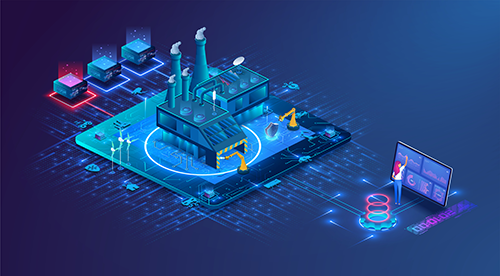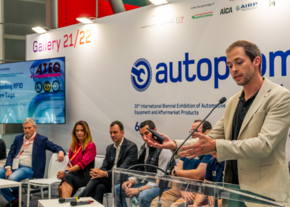
12/09/2022
From fiction to reality: welcome to the industrial metaverse
Francesca Del Bello
The virtual universe might become a crucial asset for the manufacturing sector, where with digital twin and IoT production processes are optimized
“Towards the Metaverse and beyond”: in order to imagine the new technological horizon linked to the virtual environment, we might borrow the world-famous motto by the Pixar hero – though rephrasing it. From the cyberpunk imagery to the (augmented) reality: the term “metaverse” was first used by Neal Stephenson in his 1992 novel Snow Crash, even though the idea of a virtual space, parallel to the real world, is found in a large part of the sci-fi fiction (whether it’s literary or cinematic fiction) starting from the ‘80s.
From that moment on, a series of visions more or less accurate of the cybernetic space started to follow each other – one for all, the 1999 movie Matrix. Such visions soon began to intertwine with the technological evolution going on in the real world. The first experiment, and probably the most striking for the popular imagination, was Second Life, the multimedia platform launched in 2003 by Linden Lab, that allowed its users (called “residents”) to create their own avatars and, through them, to crowd a proper virtual world. The success of the platform has been slowly declining the past few years, yet it represents a good starting point to understand of the new virtual dimension.
The relentless evolution of the sector permitted to improve a series of technologies (from virtual reality to the so-called extended reality) which made possible the evolution of the virtual environment in what we might call the metaverse: “a massively scaled and interoperable network of real-time rendered 3D virtual worlds that can be experienced synchronously and persistently by an effectively unlimited number of users with an individual sense of presence, and with continuity of data, such as identity, history, entitlements, objects, communications, and payments”, as Matthew Ball describes it in his book The Metaverse. As is clear from Ball’s quote, we are dealing with an environment which is multi-layered and compound, where a number of brands have already found their place, adopting different strategies. On the one hand, the metaverse might be used as a display to maximize their visibility, therefore increase the selling through the e-commerce channels: here, the online commerce is transformed and becomes an immersive experience so much that it was rebranded as iCommerce (that is, immersive commerce), where trading with cryptocurrency protecting transaction through the blockchain technology.
The next step, which already interests some automotive brands, is the application of the NFT (non-fungible token): it consists of a sort of “property and authenticity certifications” of a unique good – hence, non-fungible – enabled, again, through blockchain. Not an ordinary purchase, but a level of transaction that enables to reach, potentially, another level of interaction with the customer / user. A different application of the metaverse, less consumer-oriented and much more addressed towards production processes, is what we might call the “industrial metaverse”. Through a complex interplay among the technology of the digital twin, artificial intelligence, internet of things and machine learning it might be possible, for the factories, to monitor and optimize, in real time, a series of production and testing processes – hence improving performances with the chance to operate earlier than it would be possible in the real world. A platform capable to reproduce a digital twin of an entire production plant was designed by Nvidia and applied to a BMW plant, reproducing in digital the entire production division of the Regensburg plant. “If you can construct a virtual world that matches the real world in its complexity, in its scale and in its precision, then there are a great many things you can do with this,” commented Rev Lebaredian, vice president for Omniverse and simulation technology for Nvidia.
From that moment on, a series of visions more or less accurate of the cybernetic space started to follow each other – one for all, the 1999 movie Matrix. Such visions soon began to intertwine with the technological evolution going on in the real world. The first experiment, and probably the most striking for the popular imagination, was Second Life, the multimedia platform launched in 2003 by Linden Lab, that allowed its users (called “residents”) to create their own avatars and, through them, to crowd a proper virtual world. The success of the platform has been slowly declining the past few years, yet it represents a good starting point to understand of the new virtual dimension.
The relentless evolution of the sector permitted to improve a series of technologies (from virtual reality to the so-called extended reality) which made possible the evolution of the virtual environment in what we might call the metaverse: “a massively scaled and interoperable network of real-time rendered 3D virtual worlds that can be experienced synchronously and persistently by an effectively unlimited number of users with an individual sense of presence, and with continuity of data, such as identity, history, entitlements, objects, communications, and payments”, as Matthew Ball describes it in his book The Metaverse. As is clear from Ball’s quote, we are dealing with an environment which is multi-layered and compound, where a number of brands have already found their place, adopting different strategies. On the one hand, the metaverse might be used as a display to maximize their visibility, therefore increase the selling through the e-commerce channels: here, the online commerce is transformed and becomes an immersive experience so much that it was rebranded as iCommerce (that is, immersive commerce), where trading with cryptocurrency protecting transaction through the blockchain technology.
The next step, which already interests some automotive brands, is the application of the NFT (non-fungible token): it consists of a sort of “property and authenticity certifications” of a unique good – hence, non-fungible – enabled, again, through blockchain. Not an ordinary purchase, but a level of transaction that enables to reach, potentially, another level of interaction with the customer / user. A different application of the metaverse, less consumer-oriented and much more addressed towards production processes, is what we might call the “industrial metaverse”. Through a complex interplay among the technology of the digital twin, artificial intelligence, internet of things and machine learning it might be possible, for the factories, to monitor and optimize, in real time, a series of production and testing processes – hence improving performances with the chance to operate earlier than it would be possible in the real world. A platform capable to reproduce a digital twin of an entire production plant was designed by Nvidia and applied to a BMW plant, reproducing in digital the entire production division of the Regensburg plant. “If you can construct a virtual world that matches the real world in its complexity, in its scale and in its precision, then there are a great many things you can do with this,” commented Rev Lebaredian, vice president for Omniverse and simulation technology for Nvidia.






